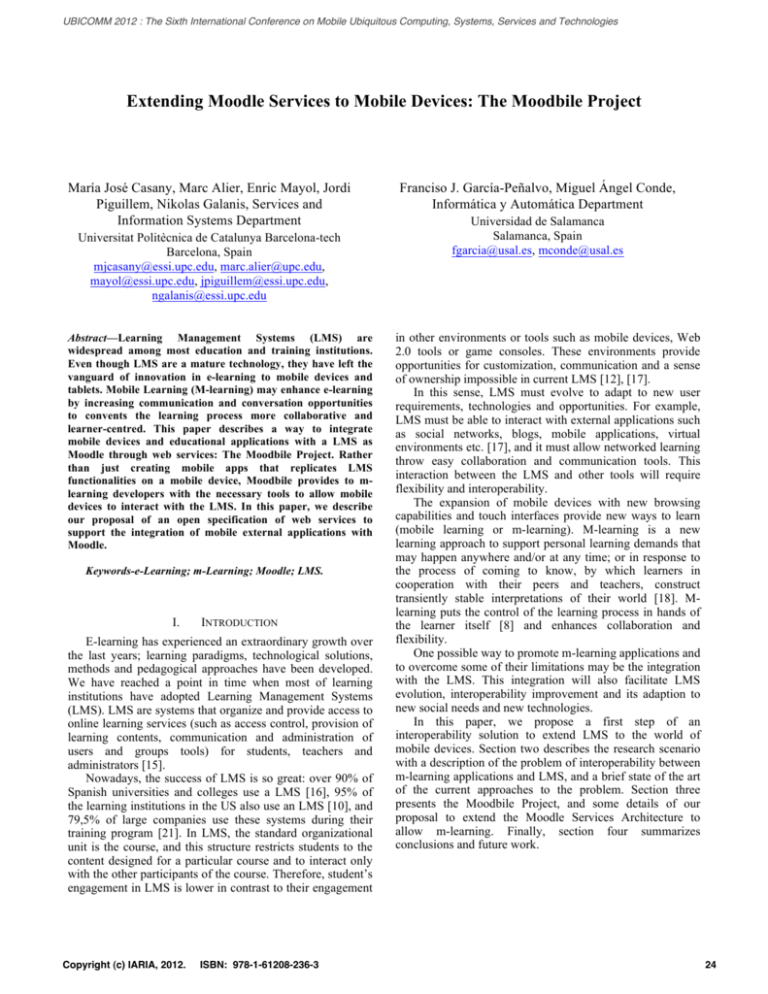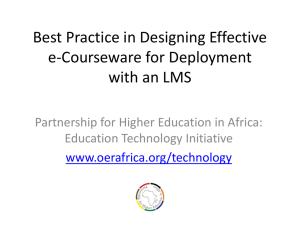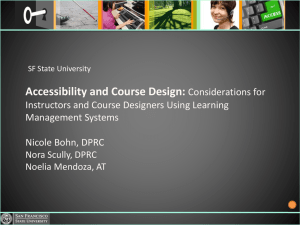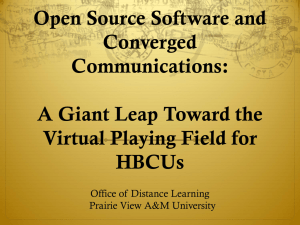Extending Moodle Services to Mobile Devices: The
advertisement

UBICOMM 2012 : The Sixth International Conference on Mobile Ubiquitous Computing, Systems, Services and Technologies Extending Moodle Services to Mobile Devices: The Moodbile Project María José Casany, Marc Alier, Enric Mayol, Jordi Piguillem, Nikolas Galanis, Services and Information Systems Department Universitat Politècnica de Catalunya Barcelona-tech Barcelona, Spain mjcasany@essi.upc.edu, marc.alier@upc.edu, mayol@essi.upc.edu, jpiguillem@essi.upc.edu, ngalanis@essi.upc.edu Abstract—Learning Management Systems (LMS) are widespread among most education and training institutions. Even though LMS are a mature technology, they have left the vanguard of innovation in e-learning to mobile devices and tablets. Mobile Learning (M-learning) may enhance e-learning by increasing communication and conversation opportunities to convents the learning process more collaborative and learner-centred. This paper describes a way to integrate mobile devices and educational applications with a LMS as Moodle through web services: The Moodbile Project. Rather than just creating mobile apps that replicates LMS functionalities on a mobile device, Moodbile provides to mlearning developers with the necessary tools to allow mobile devices to interact with the LMS. In this paper, we describe our proposal of an open specification of web services to support the integration of mobile external applications with Moodle. Keywords-e-Learning; m-Learning; Moodle; LMS. I. INTRODUCTION E-learning has experienced an extraordinary growth over the last years; learning paradigms, technological solutions, methods and pedagogical approaches have been developed. We have reached a point in time when most of learning institutions have adopted Learning Management Systems (LMS). LMS are systems that organize and provide access to online learning services (such as access control, provision of learning contents, communication and administration of users and groups tools) for students, teachers and administrators [15]. Nowadays, the success of LMS is so great: over 90% of Spanish universities and colleges use a LMS [16], 95% of the learning institutions in the US also use an LMS [10], and 79,5% of large companies use these systems during their training program [21]. In LMS, the standard organizational unit is the course, and this structure restricts students to the content designed for a particular course and to interact only with the other participants of the course. Therefore, student’s engagement in LMS is lower in contrast to their engagement Copyright (c) IARIA, 2012. ISBN: 978-1-61208-236-3 Franciso J. García-Peñalvo, Miguel Ángel Conde, Informática y Automática Department Universidad de Salamanca Salamanca, Spain fgarcia@usal.es, mconde@usal.es in other environments or tools such as mobile devices, Web 2.0 tools or game consoles. These environments provide opportunities for customization, communication and a sense of ownership impossible in current LMS [12], [17]. In this sense, LMS must evolve to adapt to new user requirements, technologies and opportunities. For example, LMS must be able to interact with external applications such as social networks, blogs, mobile applications, virtual environments etc. [17], and it must allow networked learning throw easy collaboration and communication tools. This interaction between the LMS and other tools will require flexibility and interoperability. The expansion of mobile devices with new browsing capabilities and touch interfaces provide new ways to learn (mobile learning or m-learning). M-learning is a new learning approach to support personal learning demands that may happen anywhere and/or at any time; or in response to the process of coming to know, by which learners in cooperation with their peers and teachers, construct transiently stable interpretations of their world [18]. Mlearning puts the control of the learning process in hands of the learner itself [8] and enhances collaboration and flexibility. One possible way to promote m-learning applications and to overcome some of their limitations may be the integration with the LMS. This integration will also facilitate LMS evolution, interoperability improvement and its adaption to new social needs and new technologies. In this paper, we propose a first step of an interoperability solution to extend LMS to the world of mobile devices. Section two describes the research scenario with a description of the problem of interoperability between m-learning applications and LMS, and a brief state of the art of the current approaches to the problem. Section three presents the Moodbile Project, and some details of our proposal to extend the Moodle Services Architecture to allow m-learning. Finally, section four summarizes conclusions and future work. 24 UBICOMM 2012 : The Sixth International Conference on Mobile Ubiquitous Computing, Systems, Services and Technologies II. RESEARCH FRAMEWORK In this section, we describe opportunities of m-learning and two approaches to integrate m-learning applications to LMS. A. Mobile Learning: opportunities and challenges Portability of mobile devices and their ability to connect to the Internet makes such device ideal tools for the storage of learning experiences and reference materials, as well as, to be a general tool to enhance the learning process. The Horizon Report [9] identifies mobile phones as a priority technology for next years. Mobile technologies have a special role, because they increase our communication and conversation opportunities. M-learning introduces some opportunities and challenges in the learning process. Some of the contributions of mlearning are: 1) it is learner-centered [13], 2) it is a new alternative for information delivery and 3) it enhances collaborative learning [18]. Therefore, we may state that mlearning increases learning flexibility by customizing learning to be more personalized and learner-centered [3], [20]. On the other hand, m-learning faces several challenges such as: 1) lack of teacher confidence, training or technical difficulties with mobile devices [6], [22], 2) lack of institutional support [6], [22], 3) interoperability problems with LMS which usually are designed as monolithic systems [2] and 4) limited impact because many initiatives are isolated from the rest of the learning process [11]. One possible solution to overcome these challenges and to avoid LMS extinction is the integration of m-learning initiatives with LMS. This approach has several advantages. From the technological point of view, the LMS can be a tool to spread learning innovation, and m-learning projects can be more than isolated experiments because they would be integrated with the learning dynamics of educational institutions. From the student’s point of view, they could personalize their learning process thanks to mobile devices as well as collaborate with peers. From the teacher’s point of view, they could continue to use LMS as their working platform, leaving mobile devices for students. B. Integrating m-learning with LMS: Related work Integration between m-learning applications and LMS is not an easy task, because LMS do not usually include interoperability standards to communicate with external applications; they are usually designed as monolithic or layered systems [17]. The integration of m-learning applications with LMS has two scenarios: 1) Extending the LMS to the mobile world The first scenario is based on the creation of m-learning applications that extend the scope of the LMS. Such mobile applications usually follow one of two different approaches: The first approach focuses on engagement with mobile devices and mobile native applications. The benefits of this approach include access to engaging design, free use of hardware features and fast and lightweight technology. However, the main limitation is that applications are device specific, which usually requires high development costs. The Copyright (c) IARIA, 2012. ISBN: 978-1-61208-236-3 second approach focuses on the interaction with a browser, so the technology is ubiquitous and device-independent. However it may also be slower and it may be harder to access for some smart phones. For example, the LMS Blackboard is focused on native applications for mobile devices, while Moodle follow both approaches. Usability and online/offline work are important issues when extending LMS to the mobile world. Specific restriction on mobile devices to display information and to interact with the user, must be also taken into account. Mlearning applications also allow offline work when network coverage is not available, so it is required to synchronize local data of the device with LMS data [19]. To sum up, extending LMS to the mobile scenario transforms the LMS into a web platform that must provide services to mobile devices usually using web service technology. Some of the proposals in this scenario try to create a clone mobile LMS allowing most of the LMS functions in mobile devices, without taking into account limitations of mobile devices such as data input or screen size. 2) Integrating external m-learning applications into the LMS The second scenario is based on the integration of external m-learning applications into the LMS. Since most LMS are not service oriented, any attempt to integrate external applications with the LMS must be done ad hoc. This approach has important disadvantages such as the difficulty in maintaining and extending the new integrated system or the limited impact of these solution [1], [2]. III. MOODBILE This section describes the main goals of the Moodbile project, an initiative designed to open up the LMS Moodle to the mobile scenario. First, we define the analysis requirements of the project. Second, we describe a layered architecture to adapt Moodle to the service oriented paradigm. Finally, we describe services we designed to allow mobile devices access to the LMS. A. Project definition and motivation The Moodbile project [23] aims to enable mobile learning applications to work together with the LMS. Moodbile is an open source project. Moodle is the host LMS platform. Rather than just creating mobile applications that replicate the LMS functionalities on a mobile device, Moodbile provides the developers of applications for education with the necessary tools to interact with the LMS. The motivation of the Moodbile project is to open up the most commonly used e-learning platforms and LMS, originally designed as monolithic or layered systems, to the service paradigm and to mobile world. To communicate Moodbile with the LMS, some Moodle functions are redesigned as services and they may also be used to integrate external applications into Moodle. B. Moodle Web Services Architecture Moodle Arquitecture is designed following the classic three-tiers architecture. Like a big amount of PHP applications, Domain Tier implements very atomic 25 UBICOMM 2012 : The Sixth International Conference on Mobile Ubiquitous Computing, Systems, Services and Technologies functions, and the major part of business logic is located at Presentation Tier. With the design of Moodle Web Services Architecture, two main problems had been addressed. How to solve that the main business logic is located at the Presentation tier instead of the Domain Tier, and how to design the architecture to support a variety of web services protocols without coupling business logic and such protocols. The solution proposed to Moodle Head Quarter was the architecture shown in Fig.1. Domain and Presentation tiers have not been changed with respect to Moodle Architecture. Instead of refactoring both tiers, the External tier was created. This tier is an extension of the standard Moodle External tier and can basically access methods from the standard Moodle External tier and the Moodle core The External tier is responsible for the specification and implementation of services that Moodle provides to external consumers or apps. However, this tier replicates some minor business logic and control statements. To provide full support to the most widespread Moodle web services protocols, a Connectors tier was designed. The Connector tier contains specific components that adapt service’s specifications of the External tier to the provided protocols. At the same time, this tier handles authentication and session management. Protocols supported are REST, SOAP, XML-RPC, AMF among others. Figure 1. Moodle Web Services Architecture The extension presented in Fig. 1 was created to solve the problem of integrating mobile applications with Moodle. Even though Moodle 2.0 already had a collection of web services, these web services focused on developing an API suitable for massive batch actions like user or course creation and inscriptions. These methods are not suitable for the integration of mobile learning applications. Moreover, issues as security management are not properly provided by these web services. Therefore, Moodbile project was initiated to design a Moodle extension that would turn Moodle into a web services provider for mobile applications, with the design of a web-service layer to access most suitable Moodle features for mobile applications Copyright (c) IARIA, 2012. ISBN: 978-1-61208-236-3 C. Moodbile Requirements Moodle’s External tier only provides basic services. Therefore, it must be extended to provide additional services to allow mobile application interact with the LMS. These features were identified and selected from related work (some of them described in section II.B) and from the analysis of the log of the Moodle server of our university, where we found the most used features accessed from mobile devices [5]. In the first step of the Moodbile project we have considered to include the features like: view course activities, view course participants, view student’s grades, view resources, view and upload assignments, access forums and discussions, read and reply posts, view upcoming calendar events and view user profile. D. Moodbile’s Architecture This section describes the proposed extensions to the Moodle Web Services Architecture to provide additional web services for mobile applications [4], [7]. This extension involves extending the tree tiers: The Domain tier extension re-implements some features that Moodle does not provide in the proper way to be used by Web Services, and, some additional services and features specific are provided to support Moodbile functionality. The External tier is where the actual services for mobile integration are defined and implemented. The Connectors tier is used to provide additional web services protocols and authentication methods more suitable for mobile devices, such as Oauth [14]. This extension is based in the following additions: 1) New authentication method. Moodle Web Services are oriented to academic management operations such as course creation, new users registration and students enrollment. Moreover, Moodle services consumers are under control of the same organization, so complex authentication methods are not required. Moodle users authenticate with their username/passwords or with special access tokens. To secure the connection, it may be enough to restrict IPs that will be able to invoke this web services. In a mobile environment, such mechanisms are not enough, since user/password or token authentication is not secure since this information is sent in each web service call from a mobile device, and it is not possible to establish a white list of authorized IPs. To solve this problem, Moodbile project applies an OAuth authentication mechanism allowing teachers and students to access Moodle using third-party applications in a secure way. 2) New Connectors Moodle offers several web services protocols but some (or none) of them are not suitable to a mobile environment. For this reason, Moodbile purposes several new connectors. To give support to HTML 5 applications, an AJAX compatible connector with JSON messages was implemented. This connector shares Moodle session, so user must be logged in to use an HTML 5 client. In a similar way, 26 UBICOMM 2012 : The Sixth International Conference on Mobile Ubiquitous Computing, Systems, Services and Technologies JSONP allows HTML 5 applications to access to Moodle Web Services using native authentication methods. JSON-RPC connector was implemented to add a lightweight protocol that can be used effectively form a mobile phone. This connector uses Moodle Web Services authentication methods. Finally, a JSON-RPC connector and a new REST connector are implemented using OAuth authentication. These connectors are the most commonly used for Moodbile clients for its ease to use and security improvements. 3) New Services New services are defined into the External tier and grouped in packages [24]. Packages are classified into Basic Services, Course Content Services, Personal Content Services or Platform Services. a) Basic Services Course package provides basic services to retrieve user courses information. User package provides services to list course enrolled users and their profiles. b) Course content services Services in this group allow the interaction with course content and activities. Thus, Assignment package provides services to get assignments information and to submit homework. Forum package makes possible to manage forums information, discussions and posts. Resource package provides all the services related to digital resources access. c) Personal content services Services in this group provide access to users personal content. Blog package allows read, write and access to Moodle blogs. Calendar package give access to user calendar, scheduling and events. Grade package allows to retrieve users grades and outcomes. Message package allows to use the internal messaging. d) System Services Lang package provides I18N services to develop clients that use the same terminology of the host. File package allows upload and download files form Moodle in a secure way. And System package provides host and system information services 4) Moodbile Clients Several mobile clients have developed based on HTML 5, Android and iOS. They are being used to test Moodbile Architecture and Services and to research in m-Learning topics. IV. CONCLUSIONS AND FURTHER WORK M-learning enhances collaborative learning and increases learning flexibility by allowing it to be more personalized and student-centred. But on the other hand, m-learning faces interoperability problems with LMS (the basic e-learning infrastructure of many educational institutions). The Moodbile project aims to propose an interoperability solution to integrate m-learning applications with the LMS, incorporating m-learning applications into the learning process of educational institutions. This will allow mlearning applications to widen their scope instead of being Copyright (c) IARIA, 2012. ISBN: 978-1-61208-236-3 isolated from the learning process. It also will allow LMS to be more flexible e-learning platforms. Moodbile aims to propose an open specification of web services to support the integration of external applications with the LMS. The initial version of the specification works for Moodle, but authors are working to adapt this specification to other LMS (such as Sakai and Olat) to create an LMS-independent specification. This specification is open-source and available for developers of third-part applications to use this specification. Authors are also designing special m-learning activities inside the LMS, that is, activities used from mobile devices but created inside the LMS. ACKNOWLEDGMENT This work has been partially funded by the MiPLE project (TIN2010-21695-C02-02.8) of the Spanish Ministry of Science and Innovation. REFERENCES [1] Alier, M., Casany, M.J. and Piguillem, J., “Towards mobile learning applications integration with learning management systems,” Multiplatform e-learning systems and technologies: mobile devices for ubiquitous ICT-based education, 2007, pp. 182. [2] Alier, M., Casany, M.J., Conde, M.A. and García-Peñalvo, F.J., “Interoperability for LMS: the missing piece to become the common place for e-learning innovation,” International Journal of Knowledge and Learning, 6(2), 2010, pp. 130-141. [3] Bull, S. and Reid, E., “Individualised revision material for use on a handheld computer,” In J. Attewell & C. Savill-Smith (EDS) Learning with mobile devices, Learning and skills development agency 2004, pp. 35-42. [4] Casany, M.J., Alier, M., Conde, M.A. and García-Peñalvo F. J., “SOA initiatives for eLearning: a Moodle case,” In Advanced Information Networking and Applications Workshops, 2009 (AINA'09), IEEE, pp. 750-755. [5] Casany, M.J., Alier, Mayol, E., “Using LMS activity logs to measure mobile access,” In Proceedings of third International Conference of Technology Enhaced Learning 2012. [6] Cobcroft, R.S., Towers, S. and Smith, J., Bruns, A., “Mobile learning in review: Opportunities and challenges for learners, teachers, and institutions,” In Proceedings Online Learning and Teaching (OLT) Conference 2006, pp. 21-30. [7] Conde, M.A., García-Peñalvo F. J., Casany, M.J. and Alier, M., “Adapting LMS architecture to the SOA: an architectural approach,” Fourth International Conference on Internet and Web Applications and Services 2009, IEEE, pp. 322-327. [8] Downes, S., “E-learning 2.0,” eLearning magazine: education and technology in perspectives, 2006, pp. 21-29 http://elearnmag.org/subpage.cfm, (retrieved: 04/2012). [9] Johnoson, L., Smith, R., Levine, A. and Haywood, K., “Horizon Report 2010,” Available at: http://wp.nmc.org/horizon2011/ (retrieved: 04/2012). [10] Lonn, S. and Teasley, S.D., “Saving time or innovating practice: Investigating perceptions and uses of Learning Management Systems,” In Computers & Education, 53(3), 2009, pp. 686-694. [11] Martín, S. et al., “Middleware for the development of context-aware applications inside m-Learning: Connecting e-learning to the mobile world,” In Proceedings of the Fourth International Multi-Conference on Computing in the Global Information Technology, ICCGI'09, 2009, pp. 217-222. [12] Mcloughlin C. and Lee, M.J.W., “Social software and participatory learning: Pedagogical choices with technology affordances in the 27 UBICOMM 2012 : The Sixth International Conference on Mobile Ubiquitous Computing, Systems, Services and Technologies [13] [14] [15] [16] [17] [18] Web 2.0 era,” ICT: Providing choices for learners and learning, Proceedings ascilite Singapore 2007. Naismith, L., Lonsdale, P., Vavoula, G. and Sharples, M., “Literature review in mobile technologies and learning,” FutureLab Report, 2004. OAUTH, “The OAuth 1.0 protocol RfC,” Internet Engineering Task Force (IETF). 2010. EHammer-Lahav E. Editors. available at: http://tools.ietf.org/html/rfc5849 (accessed 30/04/2012 Paulsen, M.F., “Online education Systems: Discussion and definition of terms,” In G.Web-Education Systems in Europe, Hagen: Zentrales Institut für Fernstudienforschung, FernUniversität, 2002, pp. 23-28. Prendes, M.P., “Plataformas de campus virtuales de software libre: Análisis comparativo de la situación actual de la Universidades Españolas,” Informe del Proyecto EA-2008-0257 de la Secretaría de Estado de Universidades e Investigación, 2009. Sclater, N., “Web 2.0, personal learning environments, and the future of learning management systems,” Research Bulletin, 13, 2008, pp. 2008-2009. Sharples, M., Taylor, J. and Vavoula, G., “Towards a theory of mobile learning,” In Proceedings of mLearn 2005, 1(1), pp. 1-9. Copyright (c) IARIA, 2012. ISBN: 978-1-61208-236-3 [19] Trifonova, A. and Ronchetti, M., “A general architecture to support mobility in learning,” Advanced Learning Technologies, 2004. Proceedings IEEE International Conference on 2004, pp. 26-30. [20] Vavoula, G.N. and Sharples, M., “KLeOS: A personal, mobile, knowledge and learning organisation system,” In Proceedings of the IEEE International Workshop on Mobile and Wireless Technologies in Education Aug 29-30, Vaxjo, Sweden, 2002, pp. 152-156. [21] Wexler, S., Grey, N., Miller, D., Nguyen, F. and Barnevelda, A., “Learning Management Systems: The good, the bad, the ugly... and the truth,” E-learning Guild, 2008. [22] Zawacky-Richter O., Brown, T. and Delport, R., “Factors that may contribute to the establishment of mobile learning in institutions,” Results from a Survey. Interactive mobile technologies, 1(1), 2007, pp. 40-41. [23] Moodbile website: http://moodbile.org (retrieved: 04/2012). [24] Services created for Moodbile online documentation. http://docs.moodbile.org/index.php/Moodbile_WS_Documentation_v 0.2 (retrieved: 04/2012). 28





